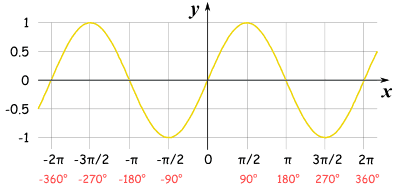2.2 Sine Graphs
Sine Graphs
Plot of Sine

The Sine Function has this beautiful up-down curve (which repeats every 2π radians, or 360°).
It starts at 0, heads up to 1 by π/2 radians (90°) and then heads down to -1.
COSECANT
Cosecant also known as cosec, is a graph of 1/sine.

COSECANT
Cosecant also known as cosec, is a graph of 1/sine.

The cosecant function has asymptotes at . It has local minima at and local maxima at .
Since it follows that and so, is an odd function. Its symmetry is captured by the statement which says that the graph of looks the same after reflection in the vertical axis and then, reflection in the horizontal axis.
Starting from the graph of , we can obtain the graph of by a transformation. Since , we have (because is an even function).
This says that we can obtain the graph of by shifting the graph of to the right by .
Comments
Post a Comment